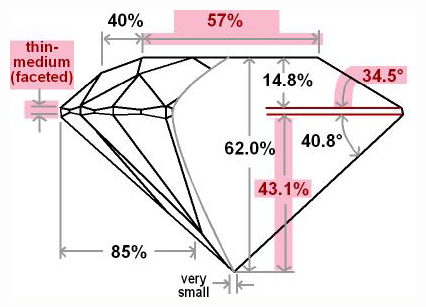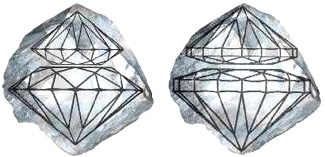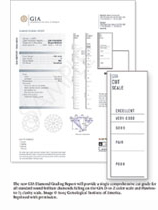New GIA Cut Grade for Diamonds
CUT CAN ACCOUNT FOR 50% OF A DIAMOND's VALUE!
What's important about GIA's new cut grading system?
And just what IS cut anyway?
That Elusive 4th C
Cut has always been the most slippery of the "4 Cs" of diamonds. The other Cs are obvious, even to non-gemologists:
- Color: colorless is best, with no brown or yellow tones to it;
- Clarity: without flaws or inclusions is tops;
- Carat weight: this means size and, for most consumers, the bigger, the better! (That popular notion misses the mark, but more of that later);
- Cut: what's to be said about Cut, which is actually the most important of the 4 Cs?
Cut refers to the geometric proportions of the gem. A diamond is a prism that refracts, or bends, light rays, breaking white light into a spectrum of color and directing it to the observer's eye. The optical proportions must be exact to achieve maximum brilliance. A diamond that is poorly cut will lack fire.
For some time gemologists have recognized the best proportions for a round brilliant diamond ("round brilliant" is the most popular shape for diamonds). This diagram shows the ideal cut proportions. The highlighted ones are most critical.

Why does cut matter so much? Because cut proportions can account for 50% of a diamond's value.
In gem cutting, waste is inevitable. On an average, about half the weight of the rough is lost in cutting a well-proportioned stone.

In this illustration, the left figure shows two well proportioned gems cut from diamond rough. The right figure shows how the same piece of rough could yield two larger stones. The larger stones are poorly proportioned and much less attractive, but they have greater carat weight.
Carat weight — size — is what most consumers recognize and are willing to pay for, so many gems on the market are cut to favor weight over beauty. This situation is effectively concealed from consumers by simply not mentioning cut proportions. Cut information is missing from 99% of the appraisals received by insurers (see the survey results for more details). And until now it has also been missing from the reports by the Gemological Institute of America's Gem Trade Lab (GTL), the country's foremost diamond grader.
GIA's New Cut Grading
 Beginning
in January 2006, GIA will include cut information on its reports/certificates
for round brilliant diamonds. This is a major step and has been much anticipated
in the gem industry. But here's a caveat: you still have to be on your toes
to know what to look for on the certificate.
Beginning
in January 2006, GIA will include cut information on its reports/certificates
for round brilliant diamonds. This is a major step and has been much anticipated
in the gem industry. But here's a caveat: you still have to be on your toes
to know what to look for on the certificate.
GIA reports "cut" in two ways.
1. A cut grade: excellent, very good, good,
fair or poor; and
2. A diagram showing the proportions of the stone.
1. Cut Grade:
The words describing cut grade can, and should, be ignored by insurers as well as customers. Rather than accepting the cut proportions generally regarded as best — and which GIA itself has taught in its courses — GIA now takes the position that various proportions can produce a beautiful stone. So stones of various proportions may merit GIA's excellent grade. How many diamonds will be sold with certificates saying their cut is poor? These grading terms are basically what diamond cutters (who pay handsomely for certificates) want to see. They have little to do with protecting the consumer.2. Diagram:
Look to the diagram for the gem's actual cut proportions. This is the information consumers should use when comparison shopping and insurers should use when pricing a replacement.
It may please customers to have a diamond report grading their stone as excellent, but this word is not descriptive gemologically. Gemologists recognize cut standards, taught by GIA and others, and base their valuations on precise cut proportions (along with other data) — not feel-good words.
People have different ideas of beauty. An individual buyer may not see the difference between an ideal cut diamond and one that gemologists regard as less well-cut, or a shopper may prefer a diamond of different proportions. Buyers who are comparison shopping should be careful to compare the cut proportions (along with the other Cs) when pricing jewelry. Asking for a diamond of "excellent" cut allows too much leeway to provide a true comparison. Many diamonds will come with GIA reports supplied by the retailer, but one "excellent" cut stone is not necessarily like another.
This is also true for the insurer who is acting as a customer: when pricing a replacement, ignore the word describing cut grade and give the jeweler the dimensions shown in the diagram.
FOR AGENTS & UNDERWRITERS
GIA will begin issuing its new reports on January 1, 2006. For diamonds graded between August 1 and December 31, 2005, GIA will issue an updated report at no charge if the original report is submitted. It would be a service to policyholders who insured diamonds during this period to inform them of this offer, and it would be of value to you to have the new report on file. You could also take the opportunity to discuss the importance of complete descriptive information on appraisals and certificates. (Diamond reports issued between January 1 and July 31, 2005, can be updated by GIA for a nominal fee.)
American Gem Society (AGS) Laboratories is another highly reputable diamond grading lab. As with the GIA report, you must look to the illustration for complete cut information. The AGS certificate carries cut information in the form of a Sarin report – an illustration of the actual diamond, produced by a machine that measures the diamond and calculates its proportions.
Remember that even a GIA or AGS diamond report is not a substitute for an appraisal. It is only independent verification of the diamond's qualities.
Look for a detailed appraisal, preferably on the insurance industry's standard
Jewelry Appraisal (ACORD 78/79),
for all information about the piece of jewelry — the stone's qualities
(including cut proportions), the metal and setting, a photo of the jewelry,
and a valuation.
Since there is such a huge market for "certified diamonds" these days, be
wary of counterfeit GIA and AGS certificates. If you have any concern about
the authenticity of a GIA report, contact the GIA Gem Trade Laboratory by
phone (760/603-4500) or fax (760/603-1814). If you suspect a forged AGS certificate,
verify the report number with AGS (702-255-6500).
FOR ADJUSTERS
When pricing replacements, look for cut information on all appraisals and diamond reports. Ignore words like excellent or very good, as these are too vague to be of any use. Look for the numbers.
For a damage claim, have the diamond inspected in a gem lab to determine cut proportions (as well as to verify other qualities) before settling the claim. Remember that cut accounts for as much as 50% of a diamond's value.
©2000-2025, JCRS Inland Marine Solutions, Inc. All Rights Reserved. www.jcrs.com

